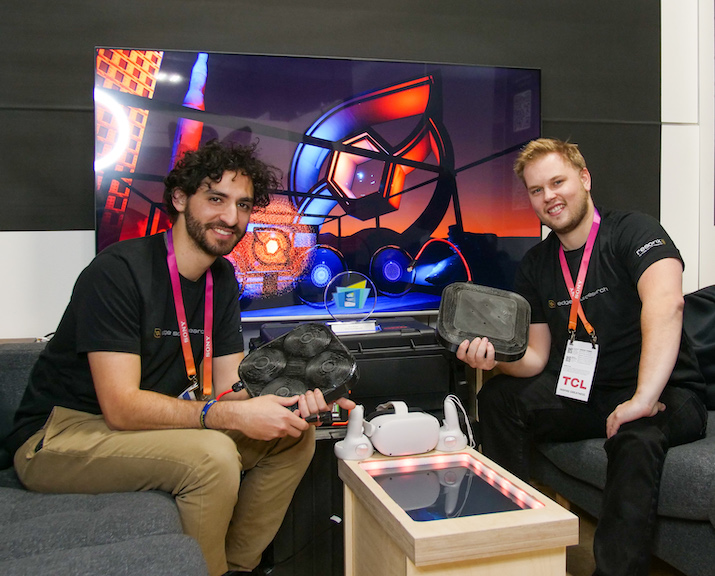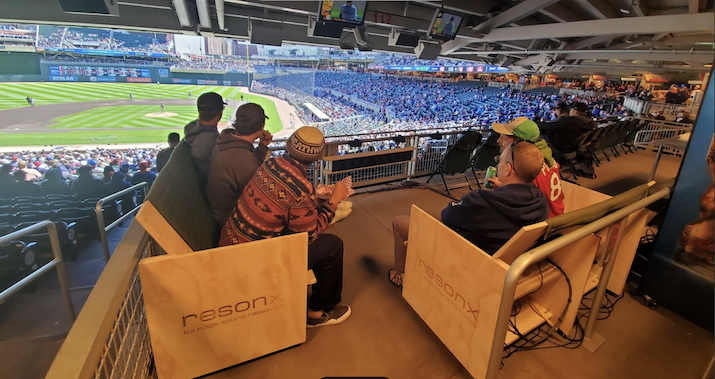EDGE Sound Research Aims To Enhance the Stadium-Sound Experience
The goal is to make fans in the stands feel every sound they hear
Story Highlights
We have surround sound (5.1 and 7.1 flavors), immersive sound, spatial audio, quadrophonic sound. Sony has a format it has dubbed Reality Sound, and Ambisonics and Dolby Atmos put a sonic roof over our heads in the form of overhead channels and objects.
Now a company called EDGE Sound Research brings “embodied sound” to the table, targeting the sports market — both broadcast and in-venue.
Embodied sound, powered by the company’s patent-pending ResonX technology, is designed to combine both auditory and physical sensations of sound in what EDGE describes as “an optimized and singular embodiment that you feel throughout your body.” It has been implemented at the Minnesota Twins’ Target Field in the form of a pair of custom lounge benches, fitted with transducers and speaker drivers, where visitors can palpably experience the crack of bat and ball and the pop of catcher’s mitt. The sounds are captured by existing microphones in the home-base area for broadcast applications, allowing the system to leverage existing audio infrastructure. Another source of the sound is a direct feed from the stadium PA system.

EDGE Sound Research’s Ethan Castro (left) and Val Salomaki are targeting sports sound, both broadcast and in-venue.
Comprising hardware including transducers and drivers that effectively turn the wooden benches into speaker-type diaphragms and converting electrical energy into motion that can vary in intensity or cadence, all managed by EDGE software, the technology goes beyond earlier haptic and tactile iterations of actuated sound, such as so-called buttkickers, according to EDGE Sound Research co-founder/CTO Ethan Castro.
In research at UC Riverside’s Experimental Acoustics Research Studio (EARS), Castro, who is hearing-challenged, focused on how to extend vibrational experiences beyond the typical 200-Hz and lower harmonic and subharmonic ranges. “I might not have been able to hear a violin,” he explains, “but I could feel its vibrations, and those are much higher frequencies than usually applied to haptic and tactile systems. My research in university was trying to figure out how far I could expand that [frequency] range.”
Sports Is the First Market
Castro and business partner CEO Val Salomaki initially figured the technology was a good fit for music and pro-audio applications, but sports came calling in a number of ways. Two of them were Chris Iles, senior director, innovation and growth, Minnesota Twins, which is historically an ambitious tech environment, and the NBA’s Launch Pad in-house research and development accelerator, which envisioned the EDGE technology synced to broadcast-audio feeds that could act as stimuli to vibrate fan seating areas. In both cases, the goal is to make spectators feel every sound they hear, even the frequencies they might otherwise not notice during a game.
“The most challenging collaboration was with the Twins, which is the pop of the mitt and the crack of the bat,” he explains. “The Twins had been experimenting with a couple of different microphone technologies, and then it’s whatever they had there for the opening game, and that was good enough. Those are very high frequencies; it’s more of a pop and a snap kind of effect. Traditionally, the easier frequencies to feel are the lower ones, so we were trying to figure out how to be able to capture upper frequencies with microphones not necessarily designed to have such a low noise floor. It took a little bit of signal processing that has to do with psychoacoustics: how your body and brain interpret what you’re hearing is big in how you separate noise from signal. There’s a significant difference between signal and noise. Our technology allows us to capture those frequencies and convert them into [physical] energy.”

Two benches in the ResonX Lounge at the Minnesota Twins’ Target Field use EDGE Sound Research tech to convert baseball sounds into tactile sensation.
EDGE Sound Research built its own benches — actually, a two-tier mobile seating lounge with backs and a table — as a proof of concept for the Twins and was allowed to move it to different parts of the stadium to test the “felt” experience at longer distances from home plate. Energizing existing seating or creating dedicated experience zones for the technology are two possible ways of deployment, Castro says.
Iles adds that the demo of what the Twins called the ResonX Lounge, part of the team’s tech-accelerator program, was successful: “As the ball is coming in, you could feel every pitch as it hit the catcher’s mitt; the crack of the bat resonated throughout your entire body, which made the viewing experience for people sitting in that sound lounge something that no one had really ever seen. I would say our test with EDGE Sound exceeded expectations.”
Plans for future deployments are to be determined, with nothing further scheduled for the 2024 season, according to Iles, but it’s possibly both a premium experience and a way to upgrade otherwise less-than-choice seats on a par with those behind home plate.
Audio Veteran Advises
EDGE Sound has brought in Dave Grundtvig, senior audio supervisor, remote operations, Warner Brothers Discovery, as a consultant. In research on and practical applications of specialty transducers for the NBA’s Orlando COVID-era “bubble,” he developed ways to implement microphones and other vibration capture under the floorboards and other locations to enhance the broadcasts’ audio effects.
“I do live sound and broadcast audio,” he notes. “I can bring that knowledge to what [EDGE Sound is] trying to accomplish with getting a more physical experience into the seat and even to the viewer at home.” He’s also adapting the use of steerable array microphones, such as the Shure MXA710, which he pioneered for NBA and MLB broadcasts, for embodied sound.
The software, which can tune out unwanted noise around the desired effects, such as bat cracks, is viable, Grundtvig says, though noting that implementing it throughout an entire venue would require a possibly cost-prohibitive amount of wiring. The technology could be more scalable if it can be done wirelessly, he adds, but, in the meantime, it’s a good fit for premium seating and for special applications, such as sensory rooms used to minimize noise for highly sensitive people.
Venue Sound Ready for the Next Phase
Salomaki sees the initial sports market in premium seating and season-ticket holders. “Currently, it’s all about enhancing premium sections within existing venue spaces,” he says. “The premium side makes a lot more sense right now for small-batch deployments. Over time, as the technology evolves, we can do things like more wireless deployment that allows us to scale it out and make it a venue-based system.”
He is unapologetically ambitious, with a stated goal to “dominate the stadium market.” But he believes that the sports sector might be at an inflection point, one created by broadcast-sports audio’s increasing ability to bring viewers closer to the field of play and the athletes on it. He wants to give everyone in the venue the audio access that Jack Nicholson and Spike Lee get courtside.
“There’s a lot of limitations on what venue sound can currently do,” Salomaki explains. “We believe we’re a solution to those, as well as a way to provide a new layer of fan engagement. Especially in the sports market, every fan wants to be as close to the action as possible, but, unless you’re watching a basketball game courtside, you can’t get that experience. We can provide that experience at any point within the venue space.”
Besides the Twins, Salomaki adds, there is interest in the technology from NBA and NHL teams. Longer range, he’s looking at motorsports and ultimately extending its reach into the home.
“The technology works,” he says. “There’s a lot of runway ahead.”
